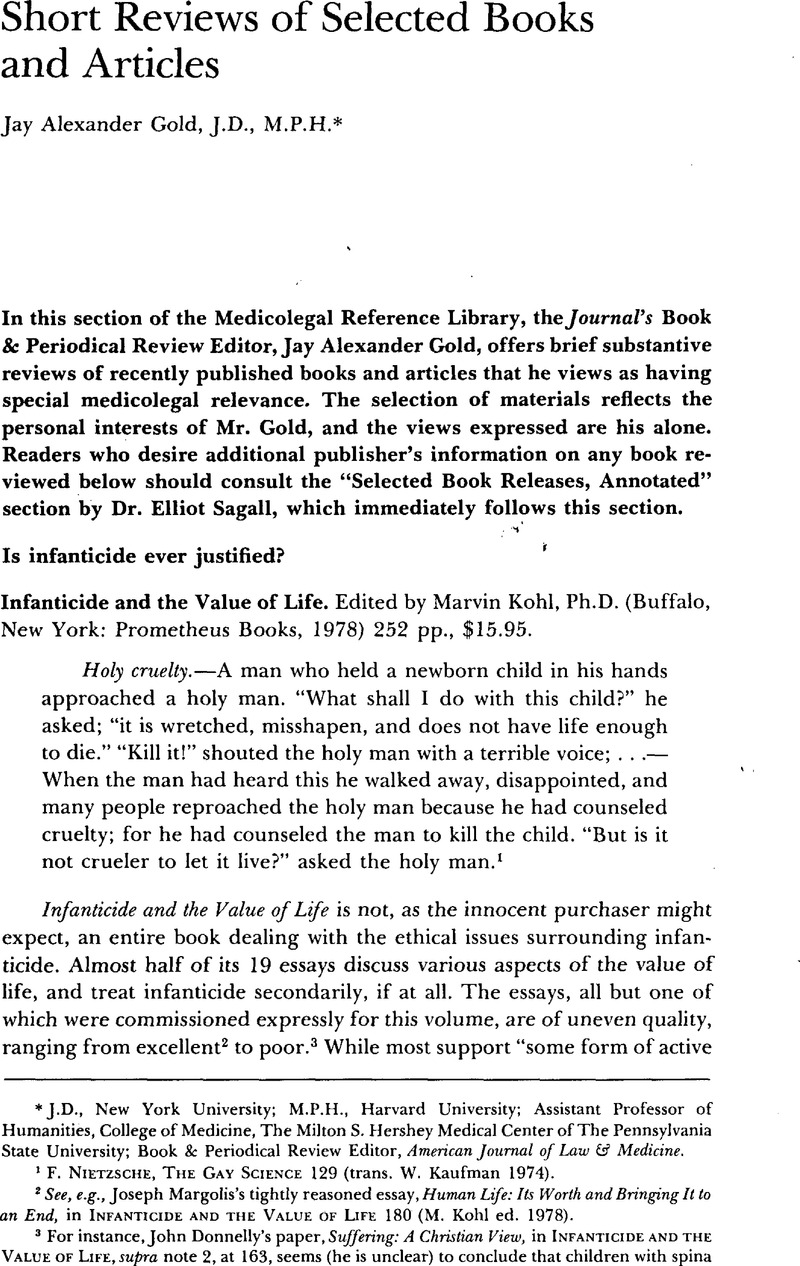No CrossRef data available.
Article contents
Short Reviews of Selected Books and Articles
Published online by Cambridge University Press: 24 February 2021
Abstract

- Type
- Medicolegal Reference Library
- Information
- Copyright
- Copyright © American Society of Law, Medicine and Ethics and Boston University 1979
References
1 NIETZSCHE, F. The Gay Science 129 (trans. Kaufman, W. 1974)Google Scholar.
2 See, e.g., Joseph Margolis's tightly reasoned essay, Human Life: Its Worth and Bringing It to an End, in Infanticide and the Value of Life 180 (Kohl, M. ed. 1978)Google Scholar.
3 For instance, John Donnelly's paper, Suffering: A Christian View, in Infanticide and the Value of Life, supra note 2, at 163, seems (he is unclear) to conclude that children with spina bifida should be kept alive so that they can experience suffering as a means “for discerning the witness of the Spirit.” Id. (quoting Soren Kierkegaard's Journals and Papers #4692 (H. Hong et al. eds. 1975)). Even one who believes that pain can be a good in some circumstances may find Donnelly's conclusions not merely illogical, but astoundingly callous.
4 Kohl, Preface to Infanticide and the Value of Life, supra note 2, at 5, 9.
5 Kluge's title, Infanticide as the Murder of Persons, indicates that he opposes infanticide; he would, however, permit it for seriously defective neonates or where termination of therapy for an infant with a poor prognosis allows limited intensive care resources to be used for an infant with a much better prognosis.
6 Weber, In Defense of the Legal Prohibition of Infanticide, in Infanticide and the Value of Life, supra note 2, at 130, 134.
7 In re Quinlan, 70 N.J. 10, 355 A.2d 647 (1976). Unfortunately, Morris misconstrues the case to have held that euthanasia was justified if Karen's guardian decided that death would be in her better interests, and preferable to prolonging her life. What the court actually held was that extraordinary treatment could be withdrawn if it was found that there was no reasonable possibility of Karen's resuming a cognitive, sapient state. Its application to infanticide is thus limited: first, where cognitivity and sapience exist or are reasonably possible at some future time—for instance, in cases of spina bifida (myelomeningocele)—the Quinlan principles would not apply; second, the decision dealt only with withdrawal of a respirator, not with euthanasia. That Karen's body is still kept breathing is proof positive of this.
8 Children from the Laboratory: A Prism Interview [with] Nobel Laureate James D. Watson, Prism, May 1973, at 12, 13. Watson cites the suggestion as originally Crick's, though Crick, as far as this reviewer knows, has never put it into print. Michael Tooley suggests “some short period of time, such as a week after birth.” Tooley, A Defense of Abortion and Infanticide, in The Problem of Abortion 51, 91 (Feinberg, J. ed. 1973)Google Scholar.
9 Tooley, supra note 8, at 91.
10 It has been suggested that we adopt “a social policy that would withhold legal personhood from certain carefully defined categories of high-risk infants until a clear diagnosis and prognosis can be made concerning them and until their parents have made an informed decision whether or not they want to keep and nurture their infants.” Jonsen, et al., Critical Issues in Newborn Intensive Care: A Conference Report and Policy Proposal, 55 Pediatrics 756, 758 (1975)Google Scholar (citing an essay by F. Raymond Marks).
11 F. Bradley, Appearance and Reality: A Metaphysical Essay at x (1930). It should be noted that the aphorism continues ”… but to find these reasons is no less an instinct.”.
12 186 Kan. 393, 350 P.2d 1093 (1960).
13 334 S.W.2d 11 (Mo. 1960).
14 The distinction between the two kinds of disclosure is emphasized in Plante, An Analysis of “Informed Consent,” 36 Fordham L. Rev. 639, 650 (1968)Google Scholar.
15 The exception is Georgia. See Young v. Yarn, 136 Ga. App. 737, 222 S.E.2d 113 (1975). Two dozen states have informed-consent statutes. The other 25 have adopted the doctrine through case law.
16 “Only the admitting physician or the surgeon ha[s] both the technical knowledge as well as the background of the particular patient's condition with which to respond [to the patient's questions].” LUDLAM, J. Informed Consent 66 (1978)Google Scholar.
17 With his usual precision and attention to detail, Ludlam distinguishes requirements that the disclosures correspond to “the practice of doctors in the same or a similar community or locality,” to “those made by a ‘reasonable medical practitioner',” and to “prevailing medical practice.” Id. at 27.
18 Id. at 29. The leading cases that have adopted this approach are Canterbury v. Spence, 464 F.2d 772 (D.C. Cir. 1972), and Cobbs v. Grant, 8 Cal. 3d 229, 502 P.2d 1, 104 Cal. Rptr. 505 (1972). Ludlam notes that where this approach is used, expert testimony still is required in order to establish the risks and alternatives, as well as causation.
19 Ludlam, supra note 16, at 42.
20 Id. at 57.
21 Id. at 59, 64.
22 Id. at 1.


